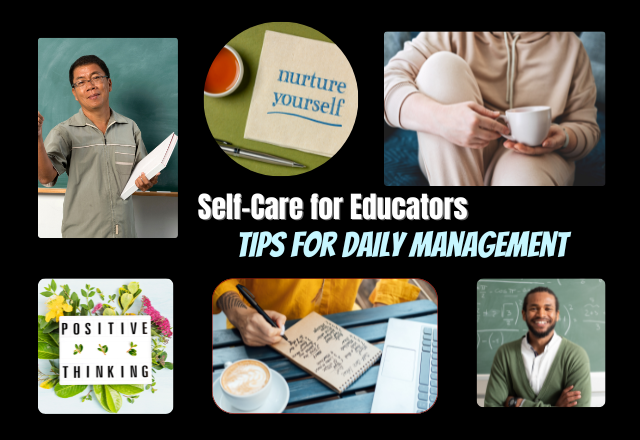Self-Care for Teachers: Thriving, Not Just Surviving
As educators, we pour so much of ourselves into our classrooms. We’re there to meet the needs of our students, cultivate creativity, and create an engaging environment—all while juggling countless other responsibilities. But it’s easy to forget one essential piece of the puzzle: taking care of ourselves.
Without self-care, our energy, patience, and passion can run dry, making it harder to be the effective teachers our students need. So, in the spirit of taking a breather (especially during Spring Break), I wanted to share some self-care tips based on both science and personal experience. These aren’t just feel-good ideas—they’re actionable steps that can truly help keep you balanced throughout the school year. Let’s dive in.
Rule #1: Drink Water
It sounds basic, but staying hydrated is essential. Dehydration leads to headaches, fatigue, and poor focus—all things that make teaching much harder.
If you’re teaching younger grades and bathroom breaks are scarce, plan ahead. Ask a nearby teacher to cover your class for a minute, or get creative with your planning. Trust me, keeping hydrated and avoiding that end-of-day fog is worth the hassle.
For resources to help manage classroom routines, check out Mrs. T Fox’s Resource Store on TPT.
Rule #2: Limit Alcohol During the Week
After a long day of teaching, a glass of wine may feel like a well-deserved reward. But alcohol, especially on weekdays, can mess with your sleep. While it may knock you out initially, it disrupts deeper sleep stages, leading to restless nights and groggy mornings.
Instead, consider switching up your evening routine—try herbal tea or light stretching to wind down. Give it a week and notice how your sleep improves. Better rest means better focus in front of the class.
Rule #3: Boost Your Protein Intake
Snacks matter. Instead of going hours without food and crashing later, snack on protein throughout the day. Even a spoonful of peanut butter or some almonds can keep your energy up and prevent “hangry” moments.
Pro tip: Raw spinach is one of my go-tos. I munch on it at my desk, and it’s become a running joke with my students. The best part? I’ve noticed they start bringing salads for lunch, too. Sometimes the small things we do rub off on our students in the best ways.
Rule #4: Move Your Body
Exercise doesn’t have to be a two-hour gym session. A 20-minute walk, a few yoga poses, or a quick run before school can work wonders. The key is consistency. Physical activity reduces stress, improves sleep, and boosts overall energy.
Think you don’t have time? I used to say the same thing—until I did a Time Inventory with my students. Tracking how I spent my day revealed I actually had more time than I thought.
Rule #5: Balance Work and Life
If you only take away one thing from this post, let it be this: work-life balance is key. You don’t need to be writing curriculum at 10 p.m. or spending your weekends grading. Trust me, I’ve been there. By year five, I hit a wall. I wasn’t eating right, exercising, or nurturing relationships. It was time to hit reset.
Here’s the secret: stick with what works. If a lesson plan is effective, tweak it as needed but avoid burning yourself out by constantly reinventing the wheel. Finding a rhythm in your work will help you establish balance and improve your overall quality of life.
Rule #6: Don’t Take Things Personally
Students acting out or not doing work? It’s rarely about you. They’re just teenagers (or kids!) with stresses and lives of their own.
Your job isn’t to catch them doing things wrong—it’s to support them in doing things right. Approach your class with understanding, grace, and a commitment to their success. The less energy you spend taking their behavior personally, the more energy you’ll have for productive teaching.
Rule #7: W.D.I.M.—What Does It Matter?
Before stressing about something, ask yourself: What does it matter in the long run? Will this issue be a big deal in six months? A year? Most of the time, the answer is no.
Stay present. Focus on what’s in front of you right now, and let go of the small stuff. You’ll save yourself a lot of unnecessary stress.
Rule #8: Fox’s Self-Care: A Scaffolded Approach
Think of self-care as a scaffold:
- Start with the basics—physical care. Drink water, eat well, and move.
- Focus on balance—build a routine that leaves room for life outside of work.
- Nurture your mental and spiritual health. Prayer, meditation, or reflection can help you stay centered.
When you’re balanced and whole, everyone around you benefits—especially your students. They notice when you’re in a positive place, and that energy is contagious.
Explore More Resources and Stay Connected
1. Shop Mrs. T Fox’s Resource Store on TPT
Looking for tools to manage your art classroom while keeping your sanity intact? Visit Mrs. T Fox’s Resource Store on TPT for exclusive resources, including lesson plans, organizational tools, and creative project guides.
2. Learn with Mrs. T Fox’s Online Courses
Want actionable strategies to balance your work and life while staying inspired in your teaching? Check out Mrs. T Fox’s Online Courses for expert guidance, step-by-step lessons, and inspiration.
3. Follow Mrs. T Fox on Social Media
Stay inspired and up-to-date with fresh teaching ideas and behind-the-scenes highlights by following @mrs_tfoxresources on Instagram. Discover ideas that help you spark creativity and care—for your students and yourself.
Wrapping It Up
Self-care isn’t just for surviving the school year—it’s for thriving. You can’t pour from an empty cup, so take care of yourself first. When you prioritize your well-being, everyone around you benefits, especially your students.
Stop by next week when we dive into another fun topic: The Value of Good Value (yes, pencil shading can be exciting!).
Until then, stay safe, stay hydrated, and stay fabulous!
Tiff 🙂


